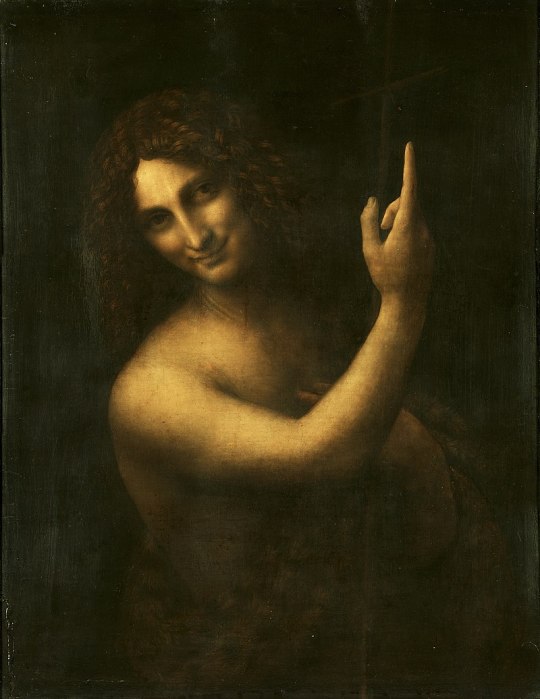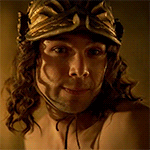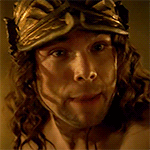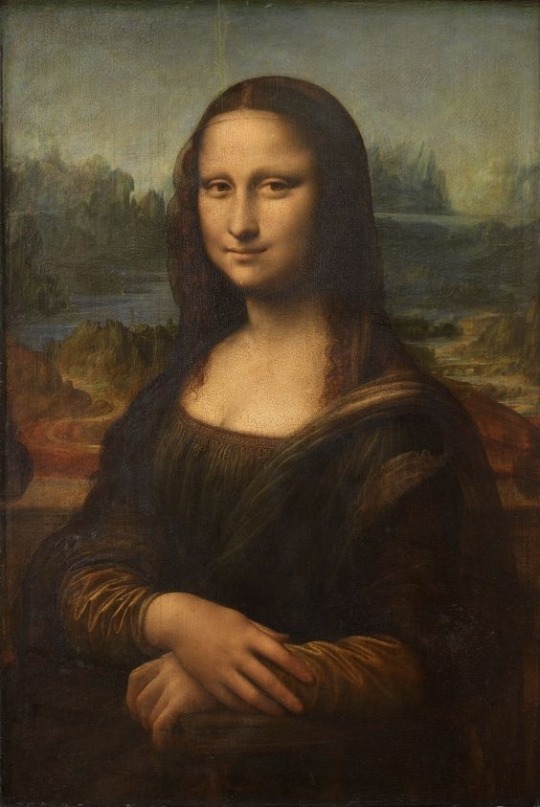#Gian Giacomo Caprotti
Text

Narcissus, variously attributed to Giovanni Antonio Boltraffio or a follower (Gian Giacomo Caprotti?), ca. 1490
#art#art history#Giovanni Antonio Boltraffio#Gian Giacomo Caprotti#classical mythology#mythological painting#Narcissus#imaginary portrait#Renaissance#Renaissance art#Italian Renaissance#Quattrocento#Italian art#15th century art#oil on canvas#National Gallery#National Gallery London
19 notes
·
View notes
Text
I have the amazing privilege to work at the Minnesota Renaissance Festival, and the even bigger privilege to portray one Gian Giacomo Caprotti, better known as Salaì.
Salaì has been a super important historical figure for me for about two years now. His existence allowed me to meet a very close friend, which in turn gave me the ability to fly all the way to Italy to meet her. I even got to eat dinner in his home town of Oreno on one of my final nights there.
The fact that I’m going to be able to spend the next several weeks embodying this person that’s brought me so much joy and opportunity throughout these past two years makes me so happy and so excited. If even one person leaves the grounds and looks him up to learn more about him, I’ll consider my job well done.
I love you Salaì, and I hope to do you justice.
(also i will be posting many stupid memes as him because what’s love if you can’t make fun of the person you love?)
#still doesn’t feel 100% real#Salaì#Renaissance Festival#Gian Giacomo Caprotti#Italian Renaissance#Renaissance Faire#RenFest#MN RenFest#Minnesota
18 notes
·
View notes
Text
Sooo I don't know if someone already talked about it but...
Have you ever noticed the similarity between Armand and Gian Giacomo Caprotti, aka il Salaì (1), favourite pupil and (almost surely) lover of Leonardo da Vinci?
If not, here some basic infos:
He was born in 1480 near Milan, we know it because we have Leonardo's diary saying that Giacomo joined his bottega in 1490, "when he was ten" (2);
He was nicknamed "Salaì" ("devil") because he was, apparently, quite a pest :)))). He was, in Leonardo's words, "a thief, a liar, stubborn, and gluttonous";
Leonardo was born in 1452, which makes him 38 years old when Giacomo joined his household (yes, the age gap);
Salaì stayed with Leonardo almost till his death and was the model for many some of his paintings and sketches (3), some of which are erotic ones;
In 1523 he married a woman called Bianca Coldirodi d'Annono.
Last but not least, Salaì looked like THIS

This is a portrait made by another (anonymous) pupil of Leonardo.
I MEAN.

He was the model for the painting Saint John the Baptist by Leonardo (on the internet, you can easily find the NSFW sketch for this painting so... yeah).
So if we look at Armand's backstory (at least, the one set in Venice with Marius), I think it's pretty easy to see the similarities:
Armand states in The Vampire Armand that he was born around 1480-81;
He was (and continue to be) a pest *affectionate*
He has a relationship with Bianca;
Marius is very Leonardo-coded for many reasons (age-gap aside, I'm really talking about his personality and attitude);
I don't think I have to comment on the features of Salaì, do I?
In conclusion, I don't think any of it is random. Anne was a fan of Reinassance Italy, I'm pretty sure she did read something about Salai and Leonardo and decided to use it in her books.
Notes
Shortcut for "Sala[d]ino" which means "Saladin" but was used at the time to say "devil" because... well, period typical islamophobia. But you have to admit, the fact that his nickname was Devil, is something.
The Italian Wiki also gives a birth date: 27th December but I don't know the source (however, this is really funny to me because I've always headcanoned Armand as a Capricorn).
There is also this theory according to which he was the model for the Mona Lisa, since, yes, Salaì did actually modelled for paintings of women.
#all my knowledge on the topic comes from high school textbooks and wikipedia#so pls if there is an art historian who wants to correct me or add things feel free#also i cannot find the exact point when armand talks about the year he was born#i'm just remembering stuff#armand#amc interview with the vampire#iwtv#interviw with the vampire#the vampire armand#gian giacomo Caprotti#long post#salai#the vampire chronicles#i just wanted to talk about armand#amc iwtv#iwtv 2022
27 notes
·
View notes
Text
Hate my Leonardo da Vinci obsession.
I went to wikipedia to find a specific crude sketch from Leonardo's journals to make a meme and suddenly I found my way into Salai's italian wikipedia article and now I'm going the rabbit hole about Luigi Pulci's Il Morgante to confirm a footnote in Walter Isaacson's biography of Leonardo da Vinci. According to it, Salai's (who was Leonardo's apprentice/servant/model/lover depending on your opinion) nickname (his real name was Gian Giacomo Caprotti, and he used alias Andrea Salai sometimes) means "little devil" and the term "salai" is derivative from Tuscan dialect mening "The devil's foot/leg" (I think the expression was "Il Salaino or something??) , But then he adds that the name comes from a DEMON in the epic Morgante. I took this to mean that there is a demon character in the novel (sometimes I realized as false only later)
(another fact about Salai's name is that sometimes it's spelled as Salaí, so it becomes Sa-la-i, instead of Sa-lai)
A detail I want to point out is that Leonardo had Il Morgante in his library, and it's included in his list of books he owns. So yes it's very possible Leonardo would've taken the name from there.
The funny this is that I have already went down this rabbit hole like year prior, but it ended abruptly without conclusion because I'm that type if person who starts something and then abandons it.
HOWEVER what I did find last time was that the only named demon character I've been able to find is Astarotte. So I was growing skeptical about the "salai's nickname comes from Il Morgnte" as a whole. No matter where I looked, there was no mention of a character named Salai.
But then after like.... Months into this thing plaquing me, and "researching" it on and off, I found this:
XXI 47 7 (Canto Ventunesimo)

I don't speak italian besides individual words so obviously I had no idea what the context was. However, at this point I realized to check my university library for any edition of Il Morgnte, and I managed to find a very fancy Italian edition. However I was bumped when I google translated the paragraph and it seemed that Salai did not refer to any particular character in the novel, rather, it's just a comparison "as does Salai in the fall" I guess there is a Salai named demon in the epic but like .. it's not a character technically.

TODAY i digged up these again because I was reminded of this, and saw that there was a footnore about "salay" in this page I had taken a picture of like over a year ago. Before the footnote had gone unnoticed for me, oh the regret is hitting...
According to machine translation that footnote 7. Explains that Salay refers to "other infernal power" and fallen angels (so demons at least)
WHICH IS FUNNY because I started to go down this rabit hole again because the Italian wikipedia article of Salai also mentions Salai's name coming from Il Morgante, but there it's said that: "the expression is used to evoke an infernal power" (Nell'opera L'espressione è impiegata oer evocare una potenza infernale)
So um.... I've wasted many hours of my finite life to confirm this little nuget of information. Idk where I'm going anymore.
Thanks for reading about my decent into insanity I guess
If any Italian speakers have anything they'd like to add or point out, please tell me!
5 notes
·
View notes
Text

gioconda nuda (monna vanna)
artwork by salai (gian giacomo caprotti)
4 notes
·
View notes
Text
6:14
Will never stop thinking about the fact that April in the first animated series of TMNT(198 smth). And Salaí, just. Look so similar (the hair is the thing okay: curly orange hair. That's just it)
#time diary(?)#audrey/kellie's time diary#hey! i might be wrong but the only painting ive seen of salaí just. being normal ig. was that he had a red-orange ish hair color#and April from the 19 series. has that same time of hair color yk? also maybe sane with 2k12 April too#yeah#.... dunno if i should tag this tho#salaí#gian giacomo caprotti#tmnt series#just tagging these tags. yeah 👍
1 note
·
View note
Photo









Salaì, Leonardo (S1, E4)
150x150 pixels gifs. Free to use.
#carlos cuevas#salaì#gian giacomo caprotti da oreno#leonardo#television#spanish fc#icons#resources#gifs#rp resources#gifset
16 notes
·
View notes
Text
✨The Mystery Behind Mona Lisa✨
Leonardo da Vinci. Mona Lisa. Two names that are synonymous with art, history, and mystery. The Mona Lisa is undoubtedly one of the most famous paintings in the world, with millions of people flocking to see it every year at the Louvre Museum in Paris, France.
But what makes this painting so special? Is it the enigmatic smile? The layers of hidden symbolism? The expert use of color and light?
Perhaps it is all of these things and more. For centuries, the Mona Lisa has captured the imaginations of artists, historians, and casual observers alike. The painting, created in the early 16th century, depicts a seated woman with her hands folded in her lap and a serene expression on her face. And yet, despite its seemingly straightforward subject matter, the painting has inspired countless interpretations and analyses over the years.
One of the most enduring mysteries of the Mona Lisa is the identity of the woman herself. Most historians believe that the painting is a portrait of Lisa Gherardini, the wife of Florentine merchant Francesco del Giocondo. However, some theories suggest that the woman in the painting could have been Leonardo's longtime apprentice and alleged lover, Gian Giacomo Caprotti, or even a self-portrait of the artist himself.
Another source of intrigue surrounding the Mona Lisa is the meaning behind the painting's many symbols and motifs. From the winding road in the background to the veil draped over the woman's hair, every detail in the painting has been scrutinized and dissected by scholars hoping to uncover the painting's secrets.
Despite the many questions surrounding the Mona Lisa and its creator, one thing is certain: the painting remains a timeless masterpiece that continues to captivate audiences around the world. Whether you are a casual observer or a serious art aficionado, a visit to the Louvre to see the Mona Lisa up close is an experience that is not to be missed.
-@japethripdos.
#Firstblog #Emtech #japethpogi


3 notes
·
View notes
Text
0 notes
Text
0 notes
Text
#happy salai has been dead for 500 slutty slutty years day!!#Assassin's Creed#Gian Giacomo Caprotti#Ezio Auditore#Salai
3 notes
·
View notes
Text
0 notes
Text
Going crazy over the fact that we might have more information about Salai if more Leonardo's work journals would've survived go present day
Deep sigh
#it's salai posting time again#yes I am still obsessed about him#fuck you leonardo da vinci I can't sleeo because if you#salai#gian giacomo caprotti
6 notes
·
View notes
Text
Francesco Melzi foi responsável por guardar todas as anotações, desenhos, registros, diário de um dos maiores gênios que a humanidade já teve : Leonardo da Vinci.
Por: Fred Borges
Um tributo a humanidade e a verdadeira amizade!
Embora talentosíssimo, Melzi ficou, como outros aprendizes, do mestre sobre a sombra dessa genialidade das artes e das ciências.
Um homem que se permitiu visitar os dois mundos mais profundos do conhecimento humano: a anatomia da medicina, da matemática, da engenharia, da arquitetura,da botânica, da música, da filosofia, das invenções, das inovações, da criatividade aliada a técnica, a disciplina, a saber reconhecer a vida e ao mesmo tempo a morte, a saber transferir para pintura tamanha técnica que uma fotografia digital de última geração jamais irá se tornar tão presente espiritualmente como na Santa Ceia e na Monalisa ou Mona Lisa, a ponto, esta última, de provocar da curiosidade até hoje, a morte ou especulação da causa da morte de um artista que ficou obsecado com sua expressão e começou a ter delírios, acredita-se que tinha esquizofrenia, terminando por se matar se jogando de um prédio numa calçada de Paris.
Outro assistente ou aprendiz foi responsável por terminar a Monalisa.
Quando Leonardo morreu em 1519, a pintura (entre outras) foi terminada por seu assistente e amigo próximo, Salai ou Gian Giacomo Caprotti da Oreno.( il diavolo)
Alguns historiadores da arte especularam que uma doença debilitante poderia ter resultado em paralisia do lado direito que teria dificultado seu trabalho nos últimos anos de sua vida.
A genialidade de Leonardo da Vinci estava na sua humildade, na sua simplicidade em dividir, compartilhar, ele sabia que sozinho não atingiria tamanha proliferidade de obras, dos campos da arte e da ciência, ele era um observador criterioso da vida e da morte, nada fugia ao seu olhar, do mundo microscópico da natureza da flora,fauna, da natureza humana, da política, do poder,da adaptabilidade,da anatomia de crimes, do crime da censura, daquilo que se chamava heresia, da sua homossexualidade ou da sua homoafetividade, apesar de ter sido celibatário em boa parte de sua vida, reprimindo-a para sobreviver e alocando-a em pura arte e ciência, na procura pela beleza em cada traço, em cada rasura, em cada erro, defeito, imperfeito ser humano.
Seu maior projeto foi destruído pela guerra, sua maior obra foi preservada pela paz e pelo milagre da paz em Jesus Cristo.
As últimas palavras de Leonardo da Vinci foram:
“Ofendi a Deus e a humanidade, fazendo muito pouco da minha vida."
Leonardo di Ser Piero da Vinci assim nasceu junto com a insaciável curiosidade, uma esponja que absorvia todo conhecimento disponível, acessível, e tudo que poderia se tornar novo, descontínuo, uma quebra no olhar.
De acordo com o que pediu em seu testamento, sessenta mendigos seguiram o seu cortejo revelando o que somos- nada em matéria, tudo em espírito.
Foi enterrado na Capela de Saint-Hubert, no Castelo de Amboise, mas depois com a Revolução Francesa houve a profanação do seu túmulo e seus ossos e destino permaneceram incógnita somente estudada pelas impressões digitais em sua arte, inclusive sua origem em parte árabe, ocultada por uma hegemônico pensar ocidental, acidental Católico Apostólico Romano.
Melzi foi o principal herdeiro e inventariante, e recebeu, além de todo o dinheiro de Leonardo, todos os seus cadernos, ferramentas, sua biblioteca e seus objetos pessoais.
Leonardo também se lembrou de seu antigo pupilo e companheiro, Salai, e de seu criado, Battista di Vilussis; cada um recebeu uma metade das vinhas de Leonardo, sendo que de Salai tornaram-se posses as pinturas que acompanhavam o mestre desde então.
Seus irmãos também receberam terras, e sua criada recebeu um manto negro de bom material, com as bordas de pele.
Leonardo, Salai,Melziv e os 70 mendigos em tudo ou quase tudo que tocaram modificaram a essência humana para todo o sempre, um tributo a humanidade, generosidade, simplicidade, humildade, e por fim, a genialidade!

0 notes
Photo









Salaì, Leonardo (S1, E4)
150x150 pixels gifs. Free to use.
#carlos cuevas#salaì#gian giacomo caprotti da oreno#leonardo#television#spanish fc#icons#resources#gifs#rp resources
6 notes
·
View notes